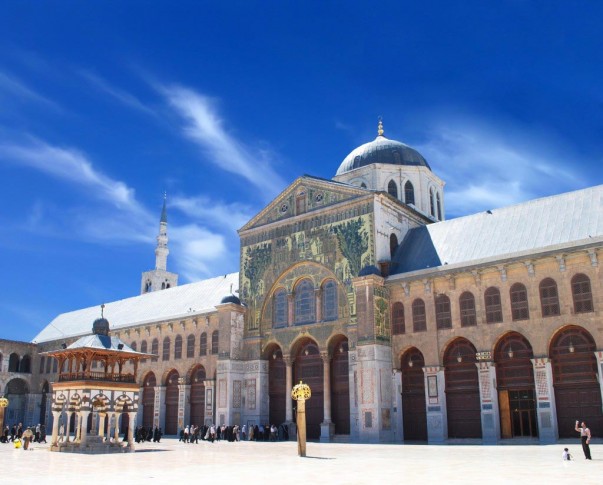The brutal killing of school children in Peshawar, is yet another reminder of the decadence of the human spirit- a race that has built cities, roads and bridges, and created designs that are a toast to nature itself. It has taken 7 million years to come so far. And yet, today, this beautiful journey is marred by man himself. We have built citadels of terror that we fear to enter, and erected walls where there should be bridges.
Here is a sad roundup of 5 marvels- both natural and man-made, which were once a traveler’s joy, and today lie as outcasts, narrating a sad tale of the descent of man, to anyone who would care to hear.
1. City of Damascus, Syria
Damascus, the capital of strife torn Syria was once the star attraction of the Middle East. Ancient Islamic architecture dating back to the second and third centuries can be found in the city. The city of Damascus, and other places in Syria are pebbled with beauties that speak volumes of the evolution of the place. The Roman ruins found in Palmyra and Apamea- brilliant visual spectacles rising from the sands of time, the 8th century Umayyad Mosque- of great importance to the worlds of Islam and architecture, the impressive and insurmountable Crac des Chevaliers and the iconic St Simeon’s Monastery- all are architectural masterpieces found in Damascus and the rest of Syria, which have withstood the test of time. But will they withstand the onslaught of mindless terrorism?
Tour companies organizing tours to Syria have suspended operations in Syria till the political atmosphere stabilizes.
2. Deep Blue Lakes of Band e Amir, Afghanistan
The six deep blue lakes of Band-e-Amir National Park in Afghanistan, at the foothills of the Hindukush mountains, call out to all who love nature in her raw earthy pristine beauty. The lakes are a natural wonder. Snow-melt from mountains comes out from faults and crack in the rocks. The carbon dioxide rich water deposited calcium carbonate, which, over time, transformed to natural reservoirs of travertine to store the deep blue water. In the winters, when snow envelopes the barren mountains, and chilly winds howl through the silent skies, the deep blue lakes- mute spectators of the destruction of the Bamiyan Buddhas-wait in anticipation of their fate.
None dare answer the call of Band-e-Amir. Tens of thousands of soldiers and civilians have lost their lives in the war in Afghanistan. The count is still on.
3. Las Geel, Somaliland, Somali
The famous rock paintings of Las Geel are in Somaliland- a self declared republic in Somalia- a country torn apart by civil war. These paintings date as far back as 3000 BC. They are surprisingly vivid depictions of cows, camels, and other animals- dressed in ceremonial robes. There are paintings of herders too. These exquisite rock paintings were discovered by a group of French archeologists in 2002 and have gained huge popularity in international circles after that.
Today, these colorful outputs of early man’s artistry point to the irony of modernization. Where man’s unschooled ancestor held a brush in his hands, civilized man today holds a gun.
4. Kahuzi Biega National Park, Democratic Republic of Congo
A sad story of corruption, exploitation and starvation. The famished populace of Congo is unaware that it sits on a wealth of mineral resources-resources that have done nothing so far to improve the quality of their life. The flora and fauna that abound in DRC are the stuff a traveler’s dreams are made of, like the Kahuzi Biega National Park.
Mt Kahuzi and Mt Biega are two volcanoes that have ceased to erupt, but have not ceased to awe onlookers with their topography. Around these volcanoes, thick tropical forests abound as far as you can see. 349 species of birds, of which 42 are endemic to the region have their homes here. The star attraction, however, is the eastern lowland gorilla. Thirteen other primates, some of them endangered, are also found. With such an abundance of flora and fauna, the park has easily made it to the UNESCO World Heritage site.
Sadly, even the gorillas have not been spared scathing bruises of the conflict. Their numbers have dwindled considerably over the years of the turmoil.
5. Abbasid Palace, Baghdad, Iraq
Abbasid Palace is the oldest standing monument of Baghdad and one of the oldest monuments in history. Dating to the 12 the century AD, the Abbasid Palace has been restored and acts as a museum. The historical relics housed in the museum and the architectural craftsmanship of the Abbasid Palace itself tell stories of the country’s Arab Islamic history. The palace on the banks of the river Tigris, built under Caliph Al Naser Ledinillah, has been even thought to be a Sharabiya school.
Perpetrators of evil fail to realize that their own lives too become interminably tangled in the clutches of darkness. Iraq is a classic example.
Defenders of the works of man and god often rise from the trodden upon masses. Many local peace building organizations have come up in Iraq. In the words of poet Al Sanaubari,
‘If I ever possess the power to protect the noble gardens and conserve, No wicked man would ever set a foot inside or dare’.
Image credits: Afghanistan Matters, Béka, Abdullah Geelah, Aziz1005, LuAnne Cadd
PT20150730
